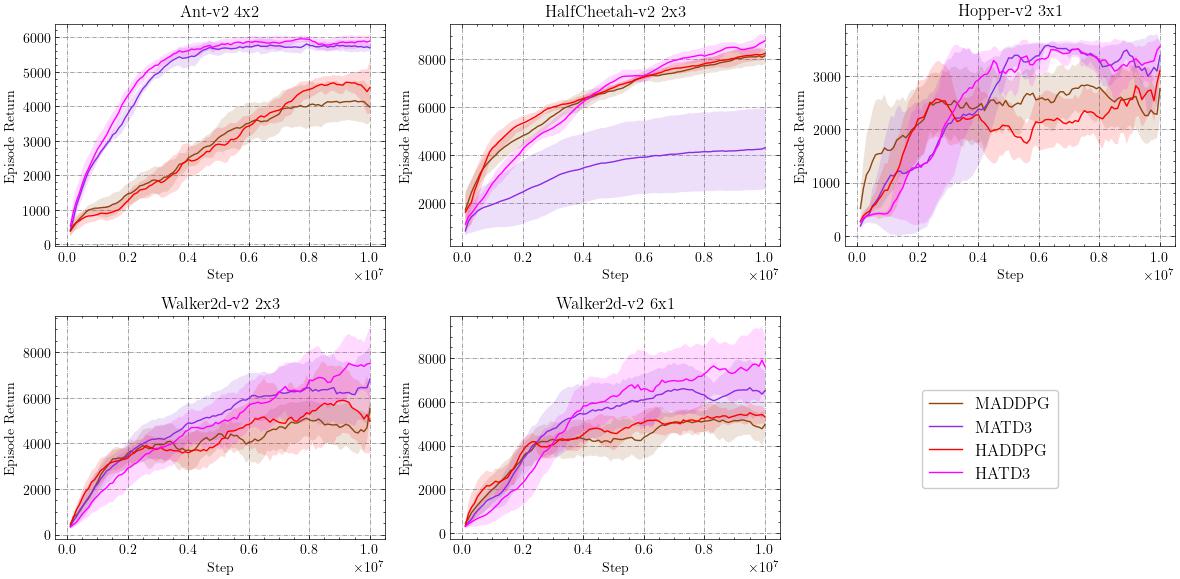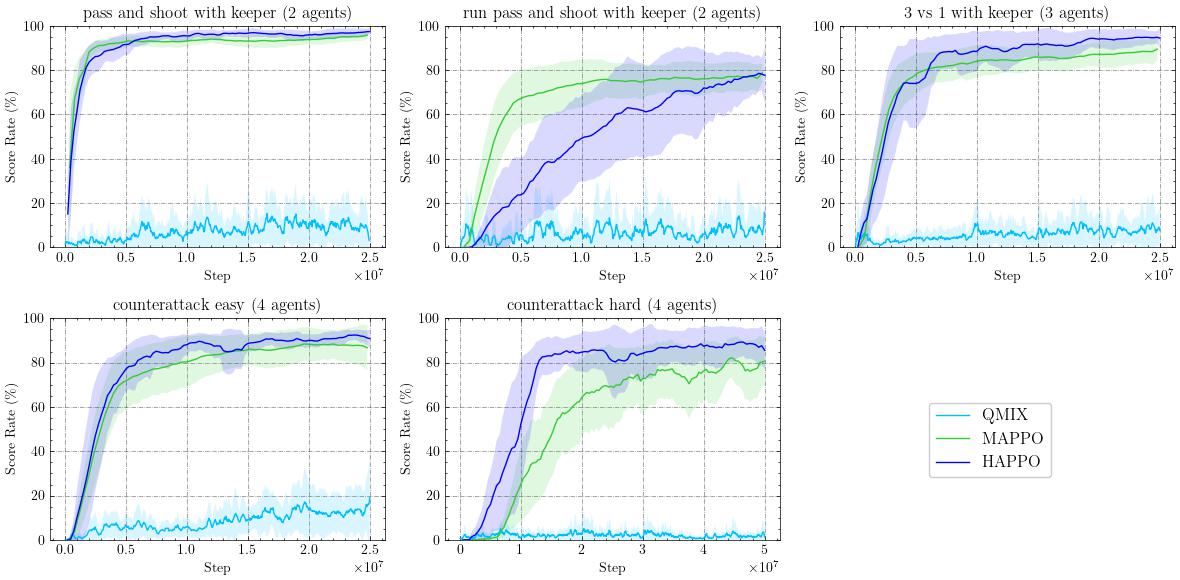This repository contains the official implementation of Heterogeneous-Agent Reinforcement Learning (HARL) algorithms, including HAPPO, HATRPO, HAA2C, HADDPG, HATD3, HAD3QN, and HASAC, based on PyTorch. HARL algorithms are markedly different from MAPPO in that they are generally applicable to heterogeneous agents and are supported by rigorous theories, often achieving superior performance. This repository allows researchers and practitioners to easily reproduce our results on seven challenging benchmarks or apply HARL algorithms to their intended applications.
HARL algorithms are our novel solutions to achieving effective multi-agent cooperation in the general heterogeneous-agent settings, without relying on the restrictive parameter-sharing trick.
- HARL algorithms achieve coordinated agent updates by employing the sequential update scheme, different from the simultaneous update scheme utilized by MAPPO and MADDPG.
- HARL algorithms enjoy theoretical guarantees of monotonic improvement and convergence to equilibrium, ensuring their efficacy in promoting cooperative behavior among agents.
- Both on-policy and off-policy HARL algorithms, exemplified by HAPPO and HASAC respectively, demonstrate superior performance across a wide range of benchmarks.
The following figure is an illustration of the sequential update scheme
For more details, please refer to our HARL (JMLR 2024) and MEHARL (ICLR 2024 spotlight) papers.
conda create -n harl python=3.8
conda activate harl
# Install pytorch>=1.9.0 (CUDA>=11.0) manually
git clone https://github.com/PKU-MARL/HARL.git
cd HARL
pip install -e .Along with HARL algorithms, we also implement the interfaces for seven common environments (SMAC, SMACv2, MAMuJoCo, MPE, Google Research Football, Bi-DexterousHands, Light Aircraft Game) and they can be used directly. (We also implement the interface for Gym. Gym is a single-agent environment, which can be seen as a special case of multi-agent environments. It is included mainly for reference purposes.) You may choose to install the dependencies to the environments you want to use.
Install Dependencies of Bi-DexterousHands
Bi-DexterousHands depend on IsaacGym. The hardware requirements of IsaacGym has to be satisfied. To install IsaacGym, download IsaacGym Preview 4 release from its official website. Then run pip install -e . under its python folder.
Install Light Aircraft Game
Light Aircraft Game (LAG) is a recently developed cooperative-competitive environment for red and blue aircraft games, offering various settings such as single control, 1v1, and 2v2 scenarios. In the context of multi-agent scenarios, LAG currently supports self-play only for 2v2 settings. To address this limitation, we introduce novel cooperative non-weapon and shoot-missile tasks where two agents collaborate to combat two opponents controlled by the built-in AI. In the non-weapon task, agents are trained to fly towards the opponents' tails while maintaining a suitable distance. In the shoot-missile task, agents learn to dodge opponent missiles and launch their own missiles to destroy the opponents.
To install LAG, run the following command:
# Install dependencies
pip install torch pymap3d jsbsim==1.1.6 geographiclib gym==0.21.0 wandb icecream setproctitle
# Initialize submodules(*JSBSim-Team/jsbsim*)
git submodule init
git submodule updateInstall Google Research Football
Please follow the official instructions to install Google Research Football.
Install SMAC
Please follow the official instructions to install SMAC.
Install SMACv2
Please follow the official instructions to install SMACv2.
Install MPE
pip install pettingzoo==1.22.2
pip install supersuit==3.7.0Install Gym Suite (Except MuJoCo)
# Install gym
pip install gym
# Install classic control
pip install gym[classic_control]
# Install box2d
conda install -c anaconda swig
pip install gym[box2d]
# Install atari
pip install --upgrade pip setuptools wheel
pip install opencv-python
pip install atari-py
pip install gym[atari]
pip install autorom[accept-rom-license]Install MuJoCo
First, follow the instructions on https://github.com/openai/mujoco-py, https://www.roboti.us/, and https://github.com/deepmind/mujoco to download the right version of mujoco you need.
Second, mkdir ~/.mujoco.
Third, move the .tar.gz or .zip to ~/.mujoco, and extract it using tar -zxvf or unzip.
Fourth, add the following line to the .bashrc:
export LD_LIBRARY_PATH=$LD_LIBRARY_PATH:/home/<user>/.mujoco/<folder-name, e.g. mujoco210, mujoco-2.2.1>/binFifth, run the following command:
sudo apt install libosmesa6-dev libgl1-mesa-glx libglfw3
pip install mujoco
pip install gym[mujoco]
sudo apt-get update -y
sudo apt-get install -y patchelfInstall Dependencies of MAMuJoCo
First follow the instructions above to install MuJoCo. Then run the following commands.
pip install "mujoco-py>=2.1.2.14"
pip install "Jinja2>=3.0.3"
pip install "glfw>=2.5.1"
pip install "Cython>=0.29.28"Note that mujoco-py is compatible with mujoco210 (see this). So please make sure to download mujoco210 and extract it into the right place.
After the installation above, run the following commands to solve dependencies.
pip install gym==0.21.0
pip install pyglet==1.5.0
pip install importlib-metadata==4.13.0To train an algorithm on a provided environment, users can modify yaml configuration files of the corresponding algorithm and environment under harl/configs/algos_cfgs and harl/configs/envs_cfgs as they wish, go to examples folder, and then start training with a one-liner python train.py --algo <ALGO> --env <ENV> --exp_name <EXPERIMENT NAME> or python train.py --load_config <CONFIG FILE PATH> --exp_name <EXPERIMENT NAME>, where the latter is mostly used when reproducing an experiment. We provide the tuned configurations for algorithms in each environments under tuned_configs folder. Users can reproduce our results by using python train.py --load_config <TUNED CONFIG PATH> --exp_name <EXPERIMENT NAME> and change <TUNED CONFIG PATH> to the absolute path of the tuned config file on their machine.
During training, users receive continuous logging feedback in the terminal.
After training, users can check the log file, tensorboard output, experiment configuration, and saved models under the generated results folder. Moreover, users can also render the trained models by setting use_render: True, model_dir: <path to trained models> in algorithm configuration file (for football users also need to set render: True in the environment configuration file), and use the same training command as above again. For SMAC and SMACv2, rendering comes in the form of video replay automatically saved to the StarCraftII/Replays folder (more details can be found here).
To enable batch running, we allow users to modify yaml configs in the command line. For each training command, users specify the special parameters in the commands with the same names as in the config files. For example, if you want to run HAPPO on SMAC tasks under three random seeds. You can customize the configs and replace train.sh with the following commands:
for seed in $(seq 1 3)
do
python train.py --algo happo --env smac --exp_name test --seed $seed
doneIf you want to apply HA series algorithms to solve new tasks, you need to implement environment interfaces, following the examples of the seven environments provided. A simplest interface may look like:
class Env:
def __init__(self, args):
self.env = ...
self.n_agents = ...
self.share_observation_space = ...
self.observation_space = ...
self.action_space = ...
def step(self, actions):
return obs, state, rewards, dones, info, available_actions
def reset(self):
return obs, state, available_actions
def seed(self, seed):
pass
def render(self):
pass
def close(self):
self.env.close()The purpose of interface is to hide environment-specific details and expose a unified interaction protocol, so that other modules could process data uniformly.
You may also want to produce continuous logging output during training. If you intend to use an on-policy algorithm, you need to implement a logger for your environment. The simplest logger can inherit from BaseLogger in harl/common/base_logger.py and implement the get_task_name function. More customised logging requirements can be fulfilled by extending or overriding more functions. We recommend referring to the existing loggers in each environment directory to get to know how it is written. If an off-policy algorithm is used, you can directly customise logging by modifying the off-policy runner code. In the end, please register the logger (if any), add a yaml config file, and add necessary code to examples/train.py, harl/utils/configs_tool.py, and harl/utils/envs_tool.py. Again, following the existing seven environment examples will be convenient.
After these steps, you can apply the algorithms immediately as above.
| Continuous action space | Discrete action space | Multi Discrete action space | |
|---|---|---|---|
| HAPPO | √ | √ | √ |
| HATRPO | √ | √ | |
| HAA2C | √ | √ | √ |
| HADDPG | √ | ||
| HATD3 | √ | ||
| HAD3QN | √ | ||
| HASAC | √ | √ | √ |
| MAPPO | √ | √ | √ |
| MADDPG | √ | ||
| MATD3 | √ |
HAPPO, HADDPG, and HATD3 outperform MAPPO, MADDPG, and MATD3; HAPPO and HATD3 are the most effective methods for heterogeneous-agent cooperation tasks.
HAPPO and HATRPO are comparable to or better than MAPPO and QMIX in SMAC and SMACv2, demonstrating their capability in mostly homogeneous-agent settings.
HAPPO consistently outperforms MAPPO and QMIX on GRF, and the performance gap increases as the number and heterogeneity of agents increase.
HAPPO consistently outperforms MAPPO, and is also better than the single-agent baseline PPO, while also showing less variance.
The experiment results of HASAC can be found at https://sites.google.com/view/meharl
This repository is affiliated with Peking University and BIGAI. If you find our paper or this repository helpful in your research or project, please consider citing our works using the following BibTeX citation:
@article{JMLR:v25:23-0488,
author = {Yifan Zhong and Jakub Grudzien Kuba and Xidong Feng and Siyi Hu and Jiaming Ji and Yaodong Yang},
title = {Heterogeneous-Agent Reinforcement Learning},
journal = {Journal of Machine Learning Research},
year = {2024},
volume = {25},
number = {32},
pages = {1--67},
url = {http://jmlr.org/papers/v25/23-0488.html}
}@inproceedings{
liu2024maximum,
title={Maximum Entropy Heterogeneous-Agent Reinforcement Learning},
author={Jiarong Liu and Yifan Zhong and Siyi Hu and Haobo Fu and QIANG FU and Xiaojun Chang and Yaodong Yang},
booktitle={The Twelfth International Conference on Learning Representations},
year={2024},
url={https://openreview.net/forum?id=tmqOhBC4a5}
}









